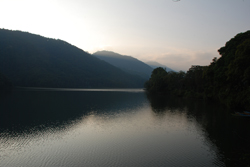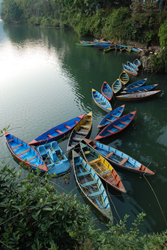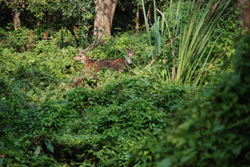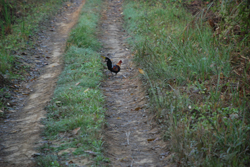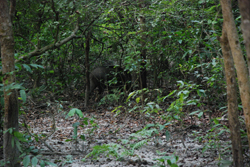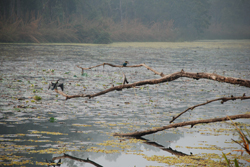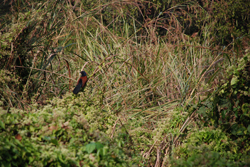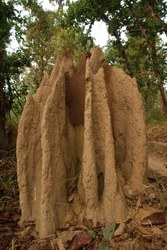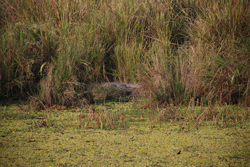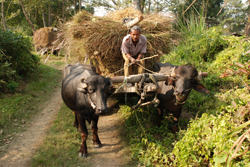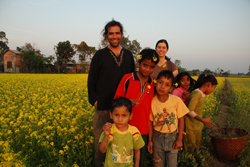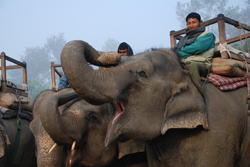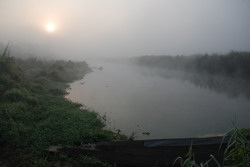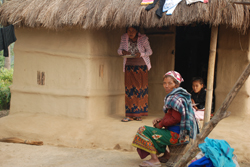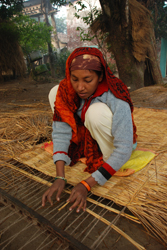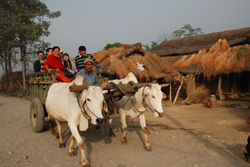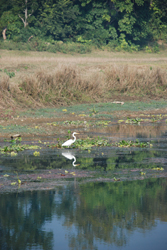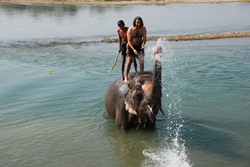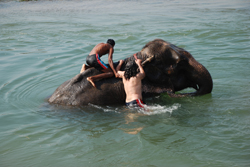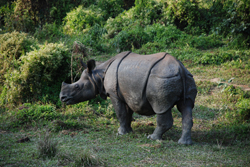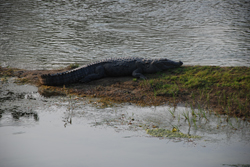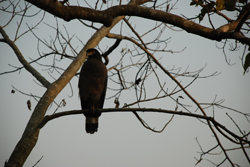Settling in Pokhara
10 December, 2008, 02:35 am in "Nepal"
By the time we reached Pokhara, the afternoon haze had hidden the mountains. After a brief walk along the lake and Lakeside, the main drag, decided we should stay here for a month instead of Kathmandu. I asked at several thangka shops and soon found someone willing to teach me.
Pokhara has a perfect location. We settled in on the lower end of the lake. Although the back streets are full of hotels, the water front is easily accessible and presents a dark green stretch of silence against the row of souvenir shops and restaurants that face it. Across the lake is quiet forest.
Pokhara has a perfect location. We settled in on the lower end of the lake. Although the back streets are full of hotels, the water front is easily accessible and presents a dark green stretch of silence against the row of souvenir shops and restaurants that face it. Across the lake is quiet forest.
The central part of the lake is crowded and the view from the street is blocked by buildings. A few restaurants have waterfront seating accessible from small alleys. The Northern part of Lakeside begins to feel more like what it had been originally with rice paddies and fishing boats on the shore and even a few non-tourist geared businesses (though most are the standard tourist fare.)
It is an unbelievably relaxing place and one where it would be easy to sit and do nothing much.
I should mention this morning the mountains were out-- glistening through the haze. From our hotel room we have a great view since behind the hotel is a garden and a vacant lot-- giving us an unobstructed view of the mountains (though the lower hills have some hotels in front).
It is an unbelievably relaxing place and one where it would be easy to sit and do nothing much.
I should mention this morning the mountains were out-- glistening through the haze. From our hotel room we have a great view since behind the hotel is a garden and a vacant lot-- giving us an unobstructed view of the mountains (though the lower hills have some hotels in front).
Chitwan Day 4: Old MacDonald
8 December, 2008, 02:16 am in "Nepal"
Chitwan National Park contains: 408 rhinos, more than 100 tigers and around 300 gaur (big water buffalo). The gharial, the rarest crocodile in the world, can also be found there.
To maximize our animal viewing opportunities, we splurged on a full day jeep safari with Ann and Steve. We anticipated finally seeing bunches of rhinos and maybe even a tiger.
We loaded into the jeep (after crossing the river by canoe) and drove off searching the forest for wildlife. Probably one of the first things we saw was a wild rooster and a couple wild pigs. The boars bolted into the forest leaving us facing a little rooster standing in the middle of the road. The jeep behind us pulled up after the boars fled. I heard them laughing at the sight of us stopped in front of the chicken.
To maximize our animal viewing opportunities, we splurged on a full day jeep safari with Ann and Steve. We anticipated finally seeing bunches of rhinos and maybe even a tiger.
We loaded into the jeep (after crossing the river by canoe) and drove off searching the forest for wildlife. Probably one of the first things we saw was a wild rooster and a couple wild pigs. The boars bolted into the forest leaving us facing a little rooster standing in the middle of the road. The jeep behind us pulled up after the boars fled. I heard them laughing at the sight of us stopped in front of the chicken.
We saw a barking deer as well as lots of the speckled variety including one male with a huge rack of antlers. We saw a green flock of parakeets fly into a tree and seem to transform into leaves. We saw a crocodile lying on its back looking dead, more boars, more chickens (including a hen), a couple monkeys and lots and lots of rhino dung. In fact, it seems like we've seen enough rhino dung to build a whole herd of rhinos. The guide said they drop about 50 Kilos of dung at a time. We drove through grassland, sal forest, riparian woodland and more forest, by lakes, rivers, and army checkpoints. We also saw some very large termite mounds.
For lunch we ate on a beach by the river. In the sand were the footprints of a tiger and cub heading off into the forest. After lunch we headed back passing a jeep that had started at the same time as us. A woman in it asked, “Did you see a tiger?” When we said no she said in a snide voice, “We did and it was THIS close” (gesturing about a foot away). Too bad it didn't chew your ugly face off, I thought. I smiled and replied, “cool”.
“What have YOU seen?” she asked, like the spoiled rich girl at school who has just announced she got the Deluxe Barbie Dream mansion with pool and golf course. Ann said, “Nothing.” I said, “What do you mean nothing? We've seen CHICKENS!” We took a different road back and passed a stream with little beach areas, each containing a sunning crocodile.
“What have YOU seen?” she asked, like the spoiled rich girl at school who has just announced she got the Deluxe Barbie Dream mansion with pool and golf course. Ann said, “Nothing.” I said, “What do you mean nothing? We've seen CHICKENS!” We took a different road back and passed a stream with little beach areas, each containing a sunning crocodile.
Then we came upon a wagon train of carts full of reeds for thatching drawn by water buffalo. There were about 7 carts. We managed to get around when they reached their destination. I remarked, “Now we've seen chickens, pigs, and cows!”“Old MacDonald's Safari.” Steve joked.
Chitwan Day 3: Escape from Tiger Camp to a Tharu Village
7 December, 2008, 02:16 am in "Nepal"
Tiger Camp Sucks! The walls are thin and lined with bamboo grass. The ceilings are also made of bamboo grass so every sound from next door sounds like it is in the same room as us. The hotel also has a bit of a rat infestation. Rats woke us up scampering around late at night. Then, around 5 AM the family began taking turns in the bathroom-- each making different noises. 2 hours later the procession was still going on. I wondered if the first had gone back in and the cycle had started over.
We decided to walk and visit one of the neighboring Tharu villages, Badrani, which we'd driven through on the way to the elephant breeding center. We passed through Sauraha, waving at the mahouts on their elephants. The villages are surrounded by golden mustard fields. The blend of their yellow flowers and light green leaves makes them seem almost neon. The village houses are simple wood, bamboo grass, and thatch structures set in an unconsciously picturesque manner at the edges of the field.
We decided to walk and visit one of the neighboring Tharu villages, Badrani, which we'd driven through on the way to the elephant breeding center. We passed through Sauraha, waving at the mahouts on their elephants. The villages are surrounded by golden mustard fields. The blend of their yellow flowers and light green leaves makes them seem almost neon. The village houses are simple wood, bamboo grass, and thatch structures set in an unconsciously picturesque manner at the edges of the field.
The first people in the Terai region of Nepal were the Tharu who came in the 13th century from Rajastan. They were able to live in the area because they developed an immunity to malaria. In the 50s, malaria was eradicated so people from the hills moved and settled.
The morning was still misty giving everything a softer, mysterious look. However, people were already up eating breakfasts of rice outside or doing other chores.
The morning was still misty giving everything a softer, mysterious look. However, people were already up eating breakfasts of rice outside or doing other chores.
At one house a woman was weaving a big mat on a loom. The completed part served as a seat. Water buffalo gazed at us with mucus dripping from their mouths and noses. Hens and chicks frantically scampered across the road. Baby goats bleated for their mother still in the shed. People were friendly and said, “hello,” or “namaste”.
Off the main street was an area with a sign, “Tharu Village and Tharu Cultural Museum”. The museum was a single, small, dark, dirt-floored room containing
various items: wooden shoes, a drum ,reed hats, rice husker (or grinder), and a wooden tool for mustard processing. One of the village girls told us what each item was in rough English. Then we walked around the village, which was a humble cluster of houses with tall pigeon houses.
various items: wooden shoes, a drum ,reed hats, rice husker (or grinder), and a wooden tool for mustard processing. One of the village girls told us what each item was in rough English. Then we walked around the village, which was a humble cluster of houses with tall pigeon houses.
Down by the river, he fog was beginning to lift. There was a fine display of bird life. By the Elephant Brothel, there was a bus and 2 horse-drawn carts full of people racing back and forth. The horse carts are small and maybe fit 4 Nepali passengers (2 Americans). They are brightly painted like miniature open gypsy caravans.
From there we walked back to the hotel in time to see the elephants being bathed. The event should probably be called “Tourist Bathing” since the main draw is the opportunity for tourists to climb on the elephant's back and receive a shower. Steve had gone and highly recommended it. Rowshan got on the back of the elephant. The elephant, Bemandakal, (Beautiful Lady) was holding a stick in her trunk which she used to scratch her belly. We joked she'd beat Rowshan with it. She dropped it as her bath began and upon orders of her mahout doused Rowshan with water. Then she rolled slowly into the water knocking Rowshan off. He had to climb back up the wet elephant. The newly bathed elephants proceeded to rub mud from the river onto their skin. I think I remember reading it keeps them from getting sunburned.
I was a bit skeptical about the elephant safari because we learned it wasn't in the park and I'd seen people riding elephants through town. One of the hotel workers assured us that though technically it wasn't part of the park, it still had lots of rhinos and was a forested jungle area, not a village tour or riding ring. In the end, it turned out to be my favorite activity of our trip here.
The forest during the late afternoon was peaceful. We ambled through with low bushes and small trees below us, sometimes brushing higher branches. The jungle was more beautiful while looking down from the elephant's back than while fighting ones way through the bushes. The light filtered gently through the tall trees, high above us making everything emerald. We went by some waterholes but didn't see any rhinos. Then we came to a green glade where the grass had been cut. There stood a rhino. He didn't seem to mind the elephants coming right up to him so we got a good look.
The forest during the late afternoon was peaceful. We ambled through with low bushes and small trees below us, sometimes brushing higher branches. The jungle was more beautiful while looking down from the elephant's back than while fighting ones way through the bushes. The light filtered gently through the tall trees, high above us making everything emerald. We went by some waterholes but didn't see any rhinos. Then we came to a green glade where the grass had been cut. There stood a rhino. He didn't seem to mind the elephants coming right up to him so we got a good look.
Out of the forest we came to a river. There, resting on a spit was a huge crocodile. We joked that it was made of concrete since it didn't move. As if to prove us wrong, he opened his mouth wide displaying his teeth. The elephants forged the river. We watched a flock of peacocks and an eagle. The platforms weren't very comfortable but the ride was lovely. The elephants finished by bringing us through the village of Badrani then through Sauraha: the daily tourist/elephant parade. The elephants only carry tourists and we haven't seen any used for other types of work. Rowshan recommended having them drag canoes upstream or carry loads of bamboo grass. Maybe when its not tourist season, they get some other jobs.
Powered by My Blog 1.69. Copyright 2003-2006 FuzzyMonkey.net.
Created by the scripting wizards at FuzzyMonkey.net..
(Code modified by Rowshan Dowlatabadi)
Created by the scripting wizards at FuzzyMonkey.net..
(Code modified by Rowshan Dowlatabadi)



